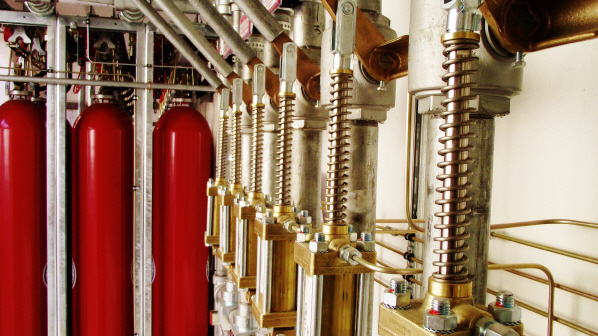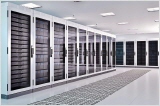
Our fire extinguishing systems protect against fire and flames quickly and reliably. But using water, foam or powder extinguishing systems is not permissible when highly sensitive systems and areas have to be protected. The negative impact of the extinguishing agent on the protected objects is too great.
This is why typical applications for gas extinguishing systems include the protection of server rooms, machine tools and other sensitive technologies. Gas extinguishing systems are reliable and effective by displacing oxygen from the fire area, or by direct intervention of the extinguishing agent in the combustion process. Various gases with different properties are used, depending on the application and the movement of persons within the protection zone.
Gases that displace oxygen
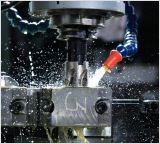
Carbon dioxide: The most common of all quenching gases, it displaces atmospheric oxygen from the fire area and thereby smothers the flames quickly and reliably. CO2 is available quickly at competitive prices. Next to the high-pressure version that is frequently found, where CO2 is stored in one or several cylinders (up to 50 kg), a low-pressure CO2 system is suitable for larger protected objects. It consists of just a single container with space for several tons of carbon dioxide.
Argon: As an inert gas of the 8th main group, argon has all of the properties required to lower the atmospheric oxygen level in the fire area and reliably smother the flames. In contrast to CO2, there is no risk of argon breaking down at elevated temperatures. This makes argon suitable even for use with extreme combustion processes, e.g. metal fires.

Nitrogen: As the main component of air, nitrogen is neither toxic nor harmful to the environment. The atmospheric oxygen is lowered by releasing the quenching gas stored in pressurised cylinders into the protection zone, smothering the fire. Nitrogen is also used frequently for inerting process sections. Here the air within the system is enriched with nitrogen so that the risk of fire is excluded from the outset.
INERGEN®: The quenching gases described above displace the existing air and lower the oxygen content of the atmosphere in the fire area. When high concentrations of inert gas are required due to the fire load, this constitutes a hazard for persons who are present in the protection zone. With a specific mixing ratio of N2, argon and CO2, INERGEN® prevents the suffocation of persons in the protection zone even when they are unconscious.
Quenching gases with a chemical effect
NOVEC1230® and FM200®: The extinguishing action of the NOVEC1230® and FM200® quenching gases is based on intervention in the combustion process. Compared to an inert gas fire extinguishing system that smothers the flames, the required extinguishing agent concentration is much lower for the same level of protection. Especially for larger protected objects, the space required for the extinguishing agent container is therefore significantly reduced. NOVEC1230® and FM200® are very popular thanks to their outstanding extinguishing action and low impact on the environment.
Next to the ability to reliably extinguish fires, all of these gases share another property as well: they dissipate with no residue after doing their job.
Structure and function of a gas extinguishing system:
An optical and thermal detector recognises the incipient fire in the protection zone and passes an electrical signal to the control unit. Triggering the system by hand is an option as well.
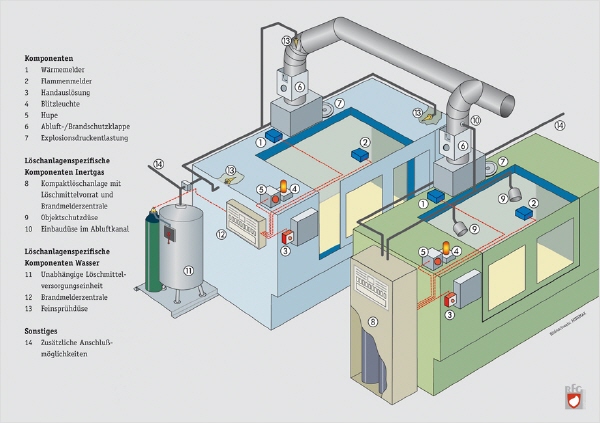
Fine water spray system (blue)/single-zone gas extinguishing system (green)
The control unit opens the valves to the gas cylinders and sets the zone valves so that the quenching gas flows through the ducts into the respective protection zone.
The flames are smothered before extensive damage to machines or systems can occur.
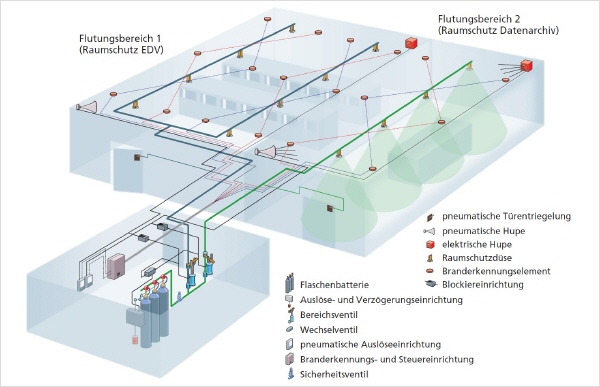
Multi-zone gas extinguishing system
Reliable protection can be realised for individual objects as well as entire rooms. By using special nozzles, the quenching gas CO2 can be routed precisely to the hazard area. This reliably maintains the required gas concentration for an adequate period of time in case of a fire.
We would be happy to provide you with a quotation to protect your industrial assets.
Please Contact us.

